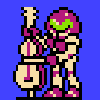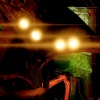2010: The Graphic Action Game (Colecovision) review"Even by the humble standards of 1984, 2010: The Graphic Action Game is light on action, none of it particularly graphic, unless you consider circuit board stills especially rousing or obscene. Worse, the misnomer does not end there. If you were to create a game based on the film 2010: The Year We Made Contact audiences today might suppose you dim, but in the early 1980s the sequel to 2001: A Space Odyssey was anticipated enough to get a Colecovision project bearing its nam..." |
Even by the humble standards of 1984, 2010: The Graphic Action Game is light on action, none of it particularly graphic, unless you consider circuit board stills especially rousing or obscene. Worse, the misnomer does not end there. If you were to create a game based on the film 2010: The Year We Made Contact audiences today might suppose you dim, but in the early 1980s the sequel to 2001: A Space Odyssey was anticipated enough to get a Colecovision project bearing its name greenlighted. The result, striking out in the categories of both film-faithfulness and graphic action, will certainly touch most as quaint. Excuse its good-natured deceit. It's not half bad.
Perhaps the biggest complaint with 2010 is that age has made it appear primitive and esoteric. It might be neither, but it's tough to call this wrong. "Graphic" depictions are limited to a space station presented in blueprinted skeleton form, whose length requires scrolling to fully see, and up close circuit views when a damaged area of the station's body is cursor selected. There, a single screen "action" sequence ensues, where you must replace damaged equipment with the corresponding component, then guide electricity through the refinished hardware, avoiding both bounding solar flares and shortcircuiting feedback loops while powering each element.
This makes it sounds a bit more technical and complicated than it is. There are only three components (each vaguely representative of the familiar RLC triad) that need cycling through, and in any case its quite obvious which component was blown. Electricity flows through the circuit by holding a button press and lifting the press to slowly ebb. At nodes (junctions in the hardware) current will pause and await a direction unable to recede (feedback loops will blow the circuit, so plan carefully). Especially during these pauses, but at any other point, the 'head' of the electrical current is susceptible to solar flare contact, causing re-damaged circuitry and starting the process anew. What the flare adds is comparable to its application in Qix, deceptively frustrating but only a nuisance part of the time. Upping the difficulty level realizes two spastic, unforgiving flares at 2010's worst.
All of this is done in an attempt to keep the space station elevated, fixing circuitry in different schematic areas to keep it afloat. Each section of the station requires a certain percentage of circuitry functioning, and dipping below that mark in an area may leave you feeling grounded on a game over screen. Care must then be taken to selectively fix the station, distributing work efforts throughout. Without documentation, it'll be hard to get a feel for how this works aside from trial and error, hence the understanding of any esoteric complaint.
It'd be hard to go into greater detail than this -- the space station is dubbed Discovery, the moon it hurtles toward Io. Who is there to save the day but a trusted, nameless engineer to rewire and reboot, exactly like in 2010: The Year We Made Contact, if such events had actually occurred in the film (likely cut because, as the title implies, the action noteworthily graphic). But none of it changes the fact that 2010: The Graphic Action game is, against instinctual judgments, actually rather entertaining despite its simplicity, incorporates niche subject matter, and happens to me to be even more enjoyable because of that niche. That may not ring as the sincerest endorsement, but if you've got nothing against Qix and its careful timed avoidance of spasmodic objects, this is certainly a clever and recommended twist on the formula.
 |  |  |  |  |
Community review by LowerStreetBlues (March 11, 2010)
A bio for this contributor is currently unavailable, but check back soon to see if that changes. If you are the author of this review, you can update your bio from the Settings page. |
|
More Reviews by LowerStreetBlues [+]
|
|
If you enjoyed this 2010: The Graphic Action Game review, you're encouraged to discuss it with the author and with other members of the site's community. If you don't already have an HonestGamers account, you can sign up for one in a snap. Thank you for reading!
User Help | Contact | Ethics | Sponsor Guide | Links













